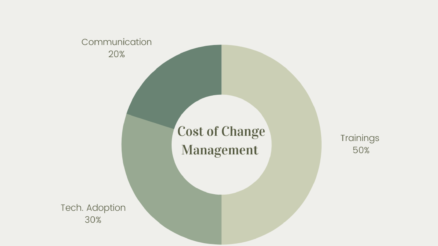Change in organizational structures, adaptation of new technologies and operation strategy is relatively easier compared to making people embracing new structures, technologies and following new strategy.
Employees are the most important factor behind success of any change initiative.
To get people ready for having change, it is necessary to have understanding of why human behaviour changes and what motivates them to adopt change.
These questions are answered by behaviour change theories and models. These models guide us what are the factors which influence human behaviour and what causes changes in human behaviour.
Among many behaviour change model, Nudge theory is the most contemporary and the relevant to the change management. This theory offers ways and techniques which leader and management you can use to understand people and engage them for implementing change.
Let’s find out what Nudge theory entails:
What is Nudge Theory?
Nudge theory was originally developed 21st century by American behavioural economists Richard Thaler and Cass Sunstein and they presented this theory is the renowned book ‘Nudge – Improving Decisions about Health, Wealth and Happiness which was published in 2008.
A nudge refers to principle that small action can influence on the choice of people or the way people behave. It focuses on engaging people by knowing that how people make choices or make decisions.
The Nudge theory encourages indirect techniques to influence the behaviour instead of giving direct instructions. This theory can be applied in every field and there are many examples of nudges in every day life.
For example, instead of saying that monitoring of diabetes is essential, availability and accessibility of glucometer can be improved which will positively influence human behaviour. Similarly, asking people to join a gym or play a sports in office, create conditions that people start using stairs.
How can Nudge Theory be helpful in Leading Change in an Organization?
As the Nudge theory central idea is to indirectly influence individuals without taking freedom of choice. It discourages any change in behaviour of employees through following strict orders and directions. It is about giving choices and through providing enabling environment and encouragement there will be change in behaviour of employees.
Organizations are nowadays using nudge theory in the workplaces to influence behavior of their employees to increase productivity and performance.
Different types of nudges can be used in change management to influence behavior. Each type of nudge addresses different factors that influence behavior, and organizations can use a combination of different types of nudges to achieve the desired outcome.
Following are the four types of nudges that are commonly used to leading change in organization.
Perception Nudges
These nudges focus on changing the way individuals perceive a specific behavior by providing them with information or changing the context in which the behavior occurs. For example, providing employees with statistics on the environmental impact of recycling would be a perception nudge.
Motivation Nudges
These nudges focus on increasing the motivation of individuals to perform a specific behavior by providing them with rewards or incentives. For example, offering employees a bonus for meeting a sales goal would be a motivation nudge.
Ability Nudges
These nudges focus on making it easier for individuals to perform a specific behavior by providing them with the necessary skills, knowledge, or resources. For example, providing employees with training on how to use a new software system would be an ability nudge.
Simplicity Nudge
These nudges focus on making it easier for individuals to perform a specific behavior by reducing the complexity of the task or decision. For example, providing employees with a simplified process for submitting expense reports would be a simplicity nudge.
05 Key Steps of Nudging for Implementing Change
There is a structured process to apply nudging in change management and following are key steps of that process:
1. Defining the problem
Defining the problem is the first step in applying Nudge theory in change management. This involves identifying the specific behavior that needs to be changed and the desired outcome. It requires a clear understanding of the problem and the impact it has on the organization, employees, and customers.
For example, if an organization wants to reduce energy consumption in the workplace, the specific behavior that needs to be changed is the excessive use of electricity by employees. The desired outcome is to reduce energy consumption and costs while also promoting environmentally-friendly practices.
Defining the problem also requires identifying the target group of people whose behavior needs to be changed. The nudges will be designed to address the specific concerns and needs of the target group. For example, if the goal is to reduce energy consumption, the target group would be employees, and the nudges would be designed to make it easy for them to conserve energy.
2. Understanding the behavior
Understanding the behavior involves analyzing the current behavior and identifying the factors that influence it. This helps to understand why the current behavior exists and what factors need to be taken into account when designing the nudge.
For example, if the goal is to reduce energy consumption in the workplace, it would be important to understand the current behavior of employees and the factors that influence their energy usage. Some factors that could be considered include:
- The layout of the workplace and the accessibility of power outlets
- The presence of energy-efficient appliances
- The level of awareness and education about energy conservation among employees
By understanding the behavior, the organization can identify what needs to be changed and what factors need to be taken into account when designing the nudge. For example, if the workplace layout and the accessibility of power outlets were identified as a factor that influences energy usage, the organization could redesign the layout to reduce the number of power outlets or make them less accessible.
3. Designing the solution
Designing the solution is about creating a nudge that addresses the problem and takes into account the factors that influence the behavior. The goal is to design a nudge that is subtle and non-coercive but still effective in encouraging the desired behavior.
For example, if the goal is to reduce energy consumption in the workplace, the organization could design a nudge that makes it easier for employees to conserve energy. This could include:
- Installing motion-sensing lights in common areas that turn off automatically when no one is present
- Providing employees with reminders to turn off lights and electronics when they are not in use
- Creating an energy-saving competition among employees to encourage them to reduce their energy usage.
When designing the solution, it is important to consider the target group of people whose behavior needs to be changed. The nudges need to be designed to address the specific concerns and needs of the target group.
4. Implementing the solution
Implementing the solution involves putting the nudge into action and making it available to the target group. The goal is to make the nudge as easy as possible for the target group to use and to ensure that it is in the right place at the right time.
Implementing the solution also includes monitoring and tracking the usage of the nudge to ensure it’s being used as intended and to identify any issues that need to be addressed. For example, if the nudge is a reminder to turn off lights and electronics, the organization could track the usage of power outlets to ensure that the nudge is having the desired effect.
It is also important to communicate the nudge to the target group, explaining how it works and why it’s beneficial, this will help to increase the chances of the target group adopting the nudge and make it more likely to achieve the desired outcome.
5. Evaluating the results
Measuring the effectiveness of the nudge and making adjustments as necessary. The goal is to determine whether the nudge is achieving the desired outcome and to identify any areas for improvement.
For example, if the goal is to reduce energy consumption in the workplace, the organization could evaluate the results by measuring the energy usage before and after the nudge was implemented. If the energy usage has decreased, it is likely that the nudge is having the desired effect. If not, the organization may need to make adjustments to the nudge or try a different approach.
Evaluating the results also includes gathering feedback from the target group to understand their experience with the nudge. This can help to identify any issues that need to be addressed and make adjustments to the nudge to improve its effectiveness.
Examples of Nudge Theory in Change Management
Following are some impactful examples of nudges that have been implemented in change managment:
Encouraging healthier eating in the workplace
Encouraging healthier eating in the workplace is an example of how Nudge theory can be applied in change management. The goal is to encourage employees to make healthier food choices while at work, which can lead to improved health and productivity.
One example of a nudge that can be used to encourage healthier eating in the workplace is to make healthier food options more visible and accessible. For example, the organization could:
- Place fruits and vegetables in more visible locations in the break room or cafeteria
- Make healthier food options more accessible by placing them at eye level in vending machines
- Use visual cues such as bright colors or healthy food labels to draw attention to healthier food options
Another example of a nudge that can be used to encourage healthier eating in the workplace is to create an environment that promotes healthy eating. For example, the organization could:
- Provide healthy eating education and resources to employees
- Host healthy eating challenges and incentives for employees who make healthy food choices
- Encourage healthy eating by making it part of the company culture, for example, by providing healthy options at company-wide meetings and events
Improving employee productivity through task management
Nudging is also used to improve employee productivity through task management. The goal is to encourage employees to be more productive by making it easier for them to manage their tasks and stay focused.
One example of a nudge that can be used to improve employee productivity through task management is to use clear and measurable goals. For example, the organization could:
- Provide employees with a detailed plan for completing large tasks, breaking them down into smaller, manageable steps
- Encourage employees to focus on one task at a time by minimizing distractions in the workplace
- Provide employees with tools and resources that make it easier for them to manage their tasks and stay focused
Increasing employee engagement through positive reinforcement
Nudging is also helpful to encourage employees to be more engaged and motivated by creating an environment that rewards and recognizes good work.
One example of a nudge that can be used to increase employee engagement through positive reinforcement is to use rewards and recognition programs. For example, the organization could:
- Set up a system of rewards and recognition for employees who go above and beyond their job responsibilities
- Provide regular feedback to employees on their performance, highlighting areas of improvement and acknowledging successes
- Create opportunities for employees to share their successes and accomplishments with their colleagues
Take Home Points
- Nudge Theory explains how to influence human behaviour in a subtle way to enforce change.
- It is about taking small actions which indirectly human behaviour towards change. It calls for influencing choice without taking power of choice from individuals.
- There are different nudges which can be taken at organization level: a) perception nudge; b) motivation nudge; c) ability and d) simplicity nudge.
- There are five steps to apply nudge theory in change management that includes defining the problem, understanding the behavior, designing the solution, implementing the solution and measuring the results.



